Stan and Jan Berenstains’ Lover Boy: Transitioning from Adult to Children’s Books
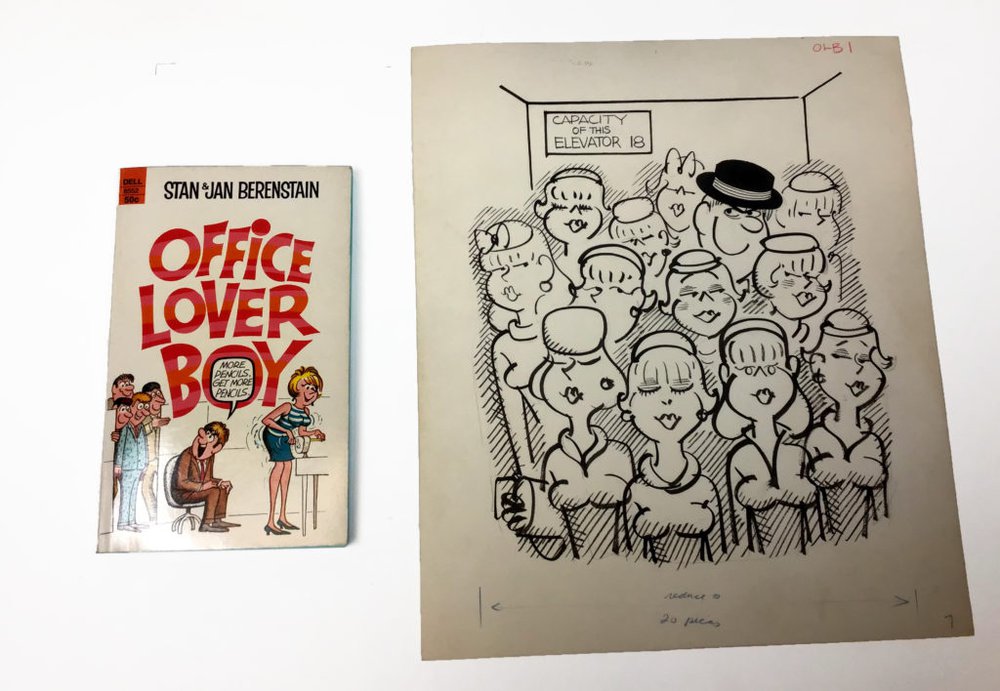
By L. Abby Houston, Graduate Assistant
Stan and Jan Berenstain are famously known for their Berenstain Bears series of children’s books. SCRC's Stan and Jan Berenstain Cartoons collection includes original artwork for some of their adult titles from 1950's-1960's including strips like Sister (1950's) and All in the Family (1950's) and book titles such as Flipsville Squaresville (1966), Call me Mrs. (1961) and several titles in the Lover Boy series.
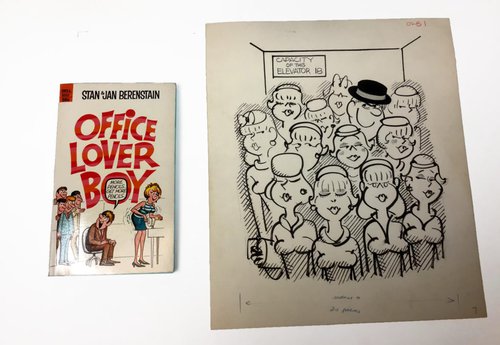
Original Artwork from Office Lover Boy with editorial comments. The original artwork is reduced in size for the final publication seen on the left.
Stan and Jan were both attending the Philadelphia Museum School of Industrial Art when they met and began producing cartoons collaboratively after the Second World War. Prior to the 1962 publication of their first Berenstain Bears book for children, The Big Honey Hunt, Stan and Jan were producing cartoons that were targeted at an older audience. From illustrated manuals, such as The Berenstains' Baby Book (1951) which gave new parent’s advice on raising a baby, to illustrated commentaries, such as Tax-Wise (1952) which presented their humorous perspective on the IRS, the Berenstains’ careers began by engaging with adults, their lives, and their problems.
The transition of their target audience from adults to kids was due to their own children, who were Dr. Seuss fans. Stan and Jan had a desire to tell them stories that were their own but more age-appropriate. Ted Geisel, otherwise known as Dr. Seuss, became their editor when Random House agreed to be the publisher for their first Berenstain Bears book.
SCRC's holdings in the Lover Boy series include the titles Lover Boy (1958), Bedside Lover Boy (1960), and Office Lover Boy (1962). These were comedic reads for adults making fun of cliché relationship behavior. For example, these particular pages below from Office Lover Boy are part of a series introducing stereotypical types of secretaries. Similar views and treatment of secretaries are familiar in recent work looking back on the time like the show Mad Men.
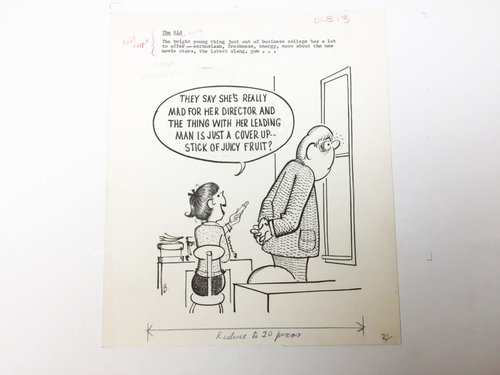
“The Kid” from Office Lover Boy, Oversize Box 4
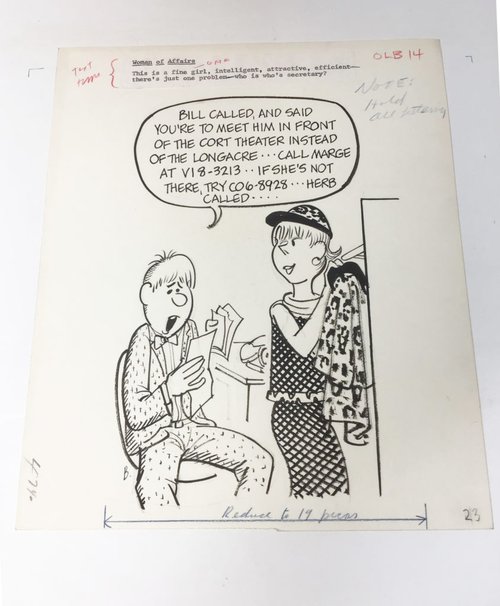
“Woman of Affairs” from Office Lover Boy, Oversize Box 4
While completely opposite from the Lover Boy series on the surface, the Berenstain Bears stories do show remnants of these same types of behavior. The Lover Boy series joked about relationship stereotypes and parenthood. Since the Berenstain Bears features a husband and wife and their family, sometimes these themes carry over, only made suitable for a younger audience.
For example, the last page of The Big Honey Hunt (1962) shows a goofy Papa Bear purchasing honey from the store after a long, and failed journey with Brother Bear to search for it in the wild. Mama Bear stands in the doorway with her all-knowing smirk, as she had told Paper Bear to simply buy it from the store at the beginning of the book. These stereotype roles – the mother who is always, and often passively, right and the bumbling family man whose ideas and plans rarely work out – were familiar and funny.
In a section on home improvement in Lover Boy (1958), these generalizations are prevalent as well. While the wife certainly looks more annoyed than Mama Bear, she stands behind her husband, who is speaking to their friends, with a facial expression that implies she knew they should have hired a contractor from the very beginning. The husband then jokes about the work he attempted to accomplish by taking on the task himself. Both of these stories poke fun at Papa Bear and the husband for their predictable behavior. In particular, these parent/husband types have persist in examples like Marge and Homer Simpson, or Ellen and Clark Griswald.
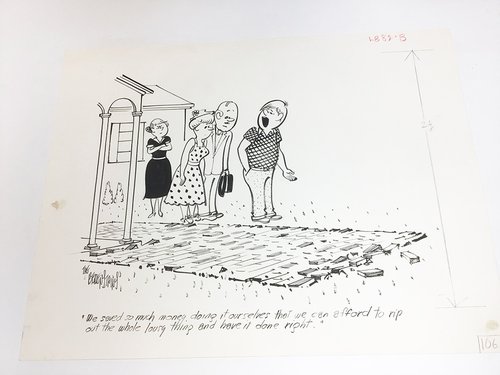
“Home Improvement” for Lover Boy, Oversize Box 1
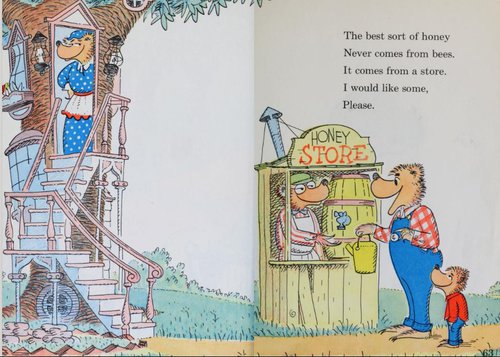
The Big Honey Hunt (New York : Random House) 1962, p. 62-63
Some of the moments within these cartoons did not age as well as others though. The gender roles for each character are clearly defined and stereotypes are certainly perpetuated that have felt more restricting than helpful as time has passed. These comics are able to give us a glimpse into the social hierarchies of marriage and office culture in the 1950s-60s as well as the Berenstains’s unique writing and artistic style. The original drawings and first edition copies of the Lover Boy series are held within our collections and can be accessed in the Reading Room should the early career of the Berenstains interest you.
The comics referenced in this post are part of our Stan and Jan Berenstain Cartoons (Stan and Jan Berenstain Cartoons, Special Collections Research Center, Syracuse University Libraries).
Additional Sources
The Berenstain Bears Official Website and Blog. (2019). Retrieved from https://berenstainbears.wordpress.com/
“Stan and Jan Berenstain,” from Illustration History: An educational resource and archive at the Norman Rockwell Museum, (2019) https://www.illustrationhistory.org/artists/stan-and-jan-berenstain
“Berenstain Facts,” from The Berenstain Bears: Down a Sunny Dirt Road at the Strong National Museum of Play, https://www.museumofplay.org/exhibits/berenstain-bears/berenstain-facts
